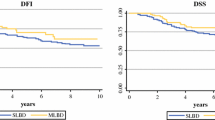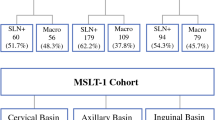Abstract
Background: Although previous studies have demonstrated that truncal site is associated with an adverse prognosis, explanations for such risk are lacking. In addition, the number of nodal basins as well as the number of lymph nodes containing regional metastases are important prognostic factors in these patients. Because the lymphatic drainage pattern of truncal melanoma often includes more than one basin, we designed a study to evaluate (1) whether patients with multiple nodal basin drainage (MNBD) were at an increased risk of lymph node metastases identified by sentinel lymph node (SLN) biopsy, and (2) whether the histological status of an individual basin reliably predicted the status of the other draining basins in patients with MNBD.
Methods: The records of 295 consecutive truncal melanoma patients who were managed primarily with intraoperative lymphatic mapping and SLN biopsy, between 1991 and 1997, were reviewed. All patients underwent preoperative lymphoscintigraphy, which established the number and location of draining nodal basins. Univariate and multivariate analyses of relevant clinicopathological factors were performed to assess which factors may predict the presence of a pathologically positive SLN.
Results: At least one SLN was identified in 281 patients. MNBD was present in 86 (31%) patients, and a pathologically positive SLN was found in 56 (20%) patients. By multivariate analysis, the presence of MNBD (relative risk = 1.9; P = .03), tumor thickness (P = .007), and tumor ulceration (relative risk = 2.4; P = .01) were significant independent risk factors for the presence of at least one pathologically positive SLN. SLN pathology in one basin did not predict the histology of other basins in 19 (22%) of 86 patients with MNBD.
Conclusions: MNBD is independently associated with an increased risk of nodal metastases in truncal melanoma patients. Because the histological status of an individual basin did not reliably predict the status of the other draining basins in patients with MNBD, it is important to adequately identify and completely assess all nodal basins at risk, as defined by lymphoscintigraphy, in truncal melanoma patients.
Similar content being viewed by others
REFERENCES
Veronesi V.1987. Prognostic factors in malignant melanoma. In: Veronesi V, Cascinelli N, Santinami M, eds. Cutaneous Melanoma: Status of Knowledge and Future Perspective. Orlando: Academic Press, pp 99–110.
Balch CM, Soong S-J, Shaw HM, et al.1985. An analysis of prognostic factors in 4000 patients with cutaneous melanoma. In: Balch CM, Milton GW, eds. Cutaneous Melanoma: Clinical Management and Treatment Results Worldwide. Philadelphia: J.B. Lippincott, pp 321–52.
Reintgen D, Cruse CW, Wells K, et al.1994. The orderly progression of melanoma nodal metastases. Ann Surg;220:759–67.
Krag D, Meijer S, Weaver D, et al.1995. Minimal-access surgery for staging melanoma. Arch Surg;130:654–8.
Morton D, Wen D, Wong J, et al. 1992Technical details of intraoperative lymphatic mapping in early stage melanoma. Arch Surg;127:392–9.
Ross M, Reintgen DS, Balch C.1993. Selective lymphadenectomy: emerging role of lymphatic mapping and sentinel node biopsy in the management of early stage melanoma. Semin Surg Oncol;9:219–23.
Gershenwald JE, Tseng C, Thompson W, et al.1998. Improved sentinel lymph node localization in patients with primary melanoma with the use of radiolabeled colloid. Surgery;124:203–10.
Gershenwald JE, Thompson W, Mansfield PF, et al.1999. Multi-institutional melanoma lymphatic mapping experience: the prognostic value of sentinel lymph node status in 612 stage I or II melanoma patients. J Clin Oncol;17:1–8.
Norman J, Wells K, Kearney R, Cruse CW, Berman C, Reintgen D.1993. Identification of lymphatic drainage basins in patients with cutaneous melanoma. Semin Surg Oncol;9:224–7.
Meyer CM, Lechletner ML, Logic JR, Balch CM, Bessey PQ, Tauxe WN.1979. Technetium-99 sulfur-colloid cutaneous lymphoscintigraphy in the management of truncal melanoma. Radiology; 131:205–9.
Wanebo HJ, Harpole D, Teates D.1985. Radionuclide lymphoscintigraphy with technetium 99m antimony sulfide colloid to identify lymphatic drainage of cutaneous melanoma at ambiguous sites in the head and neck and trunk. Cancer;55:1403–13.
Lock-Anderson J, Rossing N, Drzewiecki KT.1989. Preoperative cutaneous lymphoscintigraphy in malignant melanoma. Cancer; 63:77–82.
Norman J, Cruse W, Ruas E, et al.1989. The expanding role of lymphoscintigraphy in the management of cutaneous melanoma. Am Surgeon;55:689–94.
Balch CM, Soong S-J, Bartolucci AA, et al.1996. Efficacy of an elective lymph node dissection of 1 to 4 mm thick melanomas for patients 60 years of age or younger. Ann Surg;224:255–266.
Garbe C, Buttner P, Bertz J, et al.1995. Primary cutaneous melanoma: prognostic classification of anatomic location. Cancer;75: 2492–9.
Schuchter L, Schultz DJ, Synnestvedt M, et al.1996. A prognostic model predicting ten-year survival in patients with primary melanoma: the Pigmented Lesion Group. Ann Intern Med;125:369–75.
American Joint Committee on Cancer. Malignant melanoma of the skin. In: Fleming I, Cooper J, Henson D, et al., eds. 1997AJCC Cancer Staging Manual. Philadelphia: Lippincott-Raven, :163–70.
Sappey MPC. Anatomie, physiologie, pathologie, des vaisseaux lymphatiques consideres chez l’homme et les vertebres. Paris: A. Dehahaye et E. Lecrosnier, 1874.
Norman J, Cruse CW, Espinosa C, et al.1991. Redefinition of cutaneous lymphatic drainage with the use of lymphoscintigraphy for malignant melanoma. Am J Surg;162:435–42.
Reintgen DR.1996. More rational and conservative surgical strategies for malignant melanoma using lymphatic mapping and sentinel node biopsy techniques. Curr Opin Oncol;8:52–158.
Berger DH, Feig BW, Podoloff D, et al.1997. Lymphoscintigraphy as a predictor of lymphatic drainage from cutaneous melanoma. Ann Surg Oncol;4:13–8.
Fisher EB, Lewis VL, Griffith BH, Spies W.1992. The role of cutaneous lymphoscintigraphy in determining regional lymph node drainage of truncal melanoma. Ann Plast Surg;28:506–10.
Lieber KA, Standiford SB, Kuvshinoff BW, Ota DM.1998. Surgical management of aberrant sentinel lymph node drainage in cutaneous melanoma. Surgery;124:757–761.
Coit DG, Roggatko A, Brennan MF.1991. Prognostic factors in patients with melanoma metastatic to axillary and inguinal lymph nodes: a multivariate analysis. Ann Surg;214:627–36.
Balch CM, Ross M, Soong S-J, Harrison R. Long-term results of a prospective randomized trial involving elective regional lymph node dissection in patients with intermediate thickness melanomas. Presented at the 52nd annual meeting of the Society of Surgical Oncology, Orlando, FL, March 3–7, 1999.
Dale PS, Foshag LJ, Wanek LA, Morton DL.1997. Metastasis of primary melanoma to two separate lymph node basins: prognostic significance. Ann Surg Oncol;4:13–8.
Barth RJJr, Venzon DJ, Baker AR.1991. The prognosis of melanoma patients with metastases to two or more lymph node areas. Ann Surg;214:125–30.
Gershenwald JE, Colome MI, Lee JE, et al.1998. Patterns of recurrence following a negative sentinel lymph node biopsy in 243 patients with stage I or II melanoma. J Clin Oncol;16:2253–60.
Author information
Authors and Affiliations
Rights and permissions
About this article
Cite this article
Porter, G.A., Ross, M.I., Berman, R.S. et al. Significance of Multiple Nodal Basin Drainage in Truncal Melanoma Patients Undergoing Sentinel Lymph Node Biopsy. Ann Surg Oncol 7, 256–261 (2000). https://doi.org/10.1007/s10434-000-0256-x
Received:
Accepted:
Issue Date:
DOI: https://doi.org/10.1007/s10434-000-0256-x




